Contribution Margin: What It Is, How to Calculate It, and Why You Need It
Summary. To understand how profitable a business is, many leaders look at profit margin, which measures the total amount by which revenue from sales exceeds costs. But if you want to understand how a specific product contributes to the company’s profit, you need to look at contribution margin, which is the leftover revenue when you deduct the variable cost of delivering a product from the cost of making it. To calculate this figure, you start by looking at a traditional income statement and recategorizing all costs as fixed or variable. This is not as straightforward as it sounds, because it’s not always clear which costs fall into each category. And this is where most managers get tripped up. But going through this exercise will give you valuable information. Analyzing the contribution margin helps managers make several types of decisions, from whether to add or subtract a product line to how to price a product or service to how to structure sales commissions. But never look at contribution margin in a vacuum. Before making any major business decision, you should look at other profit measures as well.
When you run a company, it’s obviously important to understand how profitable the business is. Many leaders look at profit margin, which measures the total amount by which revenue from sales exceeds costs. But if you want to understand how a specific product contributes to the company’s profit, you need to look at contribution margin.
To understand more about how contribution margin works, I talked with Joe Knight, author of HBR Tools: Business Valuation and cofounder and owner of business-literacy.com, who says “it’s a common financial analysis tool that’s not very well understood by managers.”






